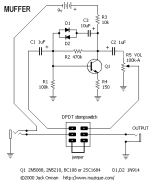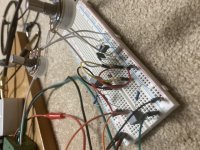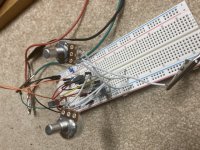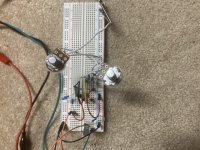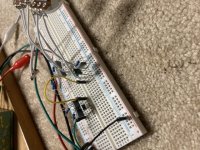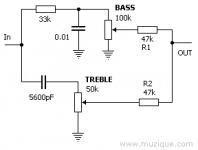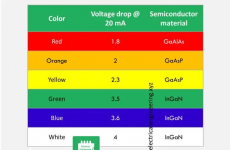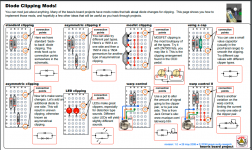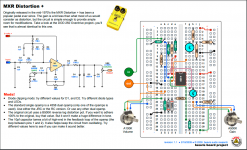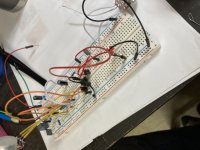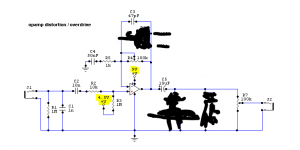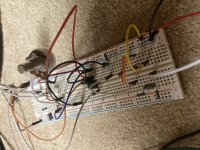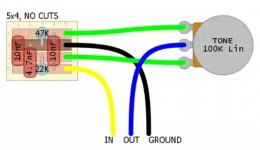BuddytheReow
Breadboard Baker
Hey all,
If you are frequent travelers of this forum you may have noticed that I've been asking a lot of breadboard questions recently. What kind of breadboard is best? How do I mount pots to them? Jumper cables? I finally bit the bullet and did a Tayda run. As of today it is still in transit. However, I realized I was trying to get rid of an Arduino starter recently (BTW still up for grabs so please message me; it is barely used) and it had a breadboard and some jumper wires in it so I decided to take it out and start!
A little background on my building/electronics...I started building toward the end of 2019. My wife just finished reading Adam Savage's (the Mythbuster's guy) autobiography and told me I would probably like it too since we were both fans of the show back in its heyday. At one point in the book there is a picture of him in his apartment kneeled on the floor over a telecaster with all it parts strewn all over the floor. He talked about just wanting to learn how things work by tinkering. Now, I've been playing guitar for almost 20 years (took almost 5 years off due to grad school and CPA exams - I am an accountant and yes, I breathe Excel ). I thought to myself after seeing that picture: "Hey, this guy has no clue about how a guitar works, but I do from a high level. Maybe I should give it a try and build a guitar." So I bought a kit which included sanding, finishing, and wiring the pickups/pots. At first I was nervous about the soldering part since I've never done something like that before. Thank you YouTube and my dad for helping out on that! Soldering was pretty simple, and THAT's what sparked the "creator" in me. From there, I decided to build a tubescreamer kit from General Guitar Gadgets. From there I stumbled upon this site and also discovered Tayda. I told myself and my wife "I can save A LOT of money building these myself!"
). I thought to myself after seeing that picture: "Hey, this guy has no clue about how a guitar works, but I do from a high level. Maybe I should give it a try and build a guitar." So I bought a kit which included sanding, finishing, and wiring the pickups/pots. At first I was nervous about the soldering part since I've never done something like that before. Thank you YouTube and my dad for helping out on that! Soldering was pretty simple, and THAT's what sparked the "creator" in me. From there, I decided to build a tubescreamer kit from General Guitar Gadgets. From there I stumbled upon this site and also discovered Tayda. I told myself and my wife "I can save A LOT of money building these myself!"  4 pedals later I decided to go down the stripboard path; again, I thought I was "saving" even more money vs buying PCBs but realized quickly the tradeoff of tidiness. Stripboard builds then required me to build a test box to essentially bypass the offboard wiring step to see if a build works and am super grateful for it. IMO, the more complex the circuit the more likely a PedalPCB purchase is necessary due to board size and again, tidiness.
4 pedals later I decided to go down the stripboard path; again, I thought I was "saving" even more money vs buying PCBs but realized quickly the tradeoff of tidiness. Stripboard builds then required me to build a test box to essentially bypass the offboard wiring step to see if a build works and am super grateful for it. IMO, the more complex the circuit the more likely a PedalPCB purchase is necessary due to board size and again, tidiness.
So....maybe 3 dozen stripboard builds and 4 pedals later, I started getting tired of building clones. Don't get me wrong, I learned a TON about circuits mostly due to troubleshooting and learning how to do that process myself mostly due to you guys and the rest of the internet. Sure, clones are nice to have, but I wanted to take the "create" process a step further and build a circuit from scratch. My only formal education was high school physics where we spent a month or two on electricity. That was 15 years ago (showing my age here) and remember virtually nothing other than ohm's law and the right hand rule (electomagnetism). Building from scratch is a tall order if you have no idea how things work.
Getting the bug to create forced me to learn a lot of the basics in circuit design and I'm still learning here. The learning process started with the basics (this is what a resistor/capacitor/diode/transistor/etc. does) and am now learning some basic pieces (basic booster, diode clipping, tone stacks, etc.). I will be sharing my builds and any notes here for anyone who wishes to go along the journey with me. First build coming soon...
If you are frequent travelers of this forum you may have noticed that I've been asking a lot of breadboard questions recently. What kind of breadboard is best? How do I mount pots to them? Jumper cables? I finally bit the bullet and did a Tayda run. As of today it is still in transit. However, I realized I was trying to get rid of an Arduino starter recently (BTW still up for grabs so please message me; it is barely used) and it had a breadboard and some jumper wires in it so I decided to take it out and start!
A little background on my building/electronics...I started building toward the end of 2019. My wife just finished reading Adam Savage's (the Mythbuster's guy) autobiography and told me I would probably like it too since we were both fans of the show back in its heyday. At one point in the book there is a picture of him in his apartment kneeled on the floor over a telecaster with all it parts strewn all over the floor. He talked about just wanting to learn how things work by tinkering. Now, I've been playing guitar for almost 20 years (took almost 5 years off due to grad school and CPA exams - I am an accountant and yes, I breathe Excel
So....maybe 3 dozen stripboard builds and 4 pedals later, I started getting tired of building clones. Don't get me wrong, I learned a TON about circuits mostly due to troubleshooting and learning how to do that process myself mostly due to you guys and the rest of the internet. Sure, clones are nice to have, but I wanted to take the "create" process a step further and build a circuit from scratch. My only formal education was high school physics where we spent a month or two on electricity. That was 15 years ago (showing my age here) and remember virtually nothing other than ohm's law and the right hand rule (electomagnetism). Building from scratch is a tall order if you have no idea how things work.
Getting the bug to create forced me to learn a lot of the basics in circuit design and I'm still learning here. The learning process started with the basics (this is what a resistor/capacitor/diode/transistor/etc. does) and am now learning some basic pieces (basic booster, diode clipping, tone stacks, etc.). I will be sharing my builds and any notes here for anyone who wishes to go along the journey with me. First build coming soon...


